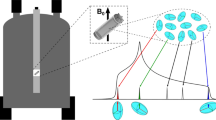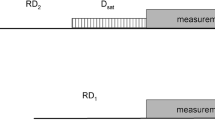Summary
19F NMR relaxation studies have been carried out on a fluorotryptophan-labeled E. coli periplasmic glucose/galactose receptor (GGR). The protein was derived from E. coli grown on a medium containing a 50:50 mixture of 5-fluorotryptophan and [2,4,6,7-2H4]-5-fluorotryptophan. As a result of the large λ-isotope shift, the two labels give rise to separate resonances, allowing relaxation contributions of the substituted indole protons to be selectively monitored. Spin-lattice relaxation rates were determined at field strengths of 11.75 T and 8.5 T, and the results were analyzed using a model-free formalism. In order to evaluate the contributions of chemical shift anisotropy to the observed relaxation parameters, solid-state NMR studies were performed on [2,4,6,7-2H4]-5-fluorotryptophan. Analysis of the observed 19F powder pattern lineshape resulted in anisotropy and asymmetry parameters of Δσ=−93.5 ppm and π=0.24. Theoretical analyses of the relaxation parameters are consistent with internal motion of the fluorotryptophan residues characterized by order parameters S2 of ∼1, and by correlation times for internal motion ∼10-11 s. Simultaneous least squares fitting of the spin-lattice relaxation and line-width data with τi set at 10 ps yielded a molecular correlation time of 20 ns for the glucose-complexed GGR, and a mean order parameter S2=0.89 for fluorotryptophan residues 183, 127, 133, and 195. By contrast, the calculated order parameter for FTrp284, located on the surface of the protein, was 0.77. Significant differences among the spin-lattice relaxation rates of the five fluorotryptophan residues of glucose-complexed GGR were also observed, with the order of relaxation rates given by: R sup183inf1F >R sup127inf1F ∼R sup133inf1F ∼R sup195inf1F >R sup284inf1F . Although such differences may reflect motional variations among these residues, the effects are largely predicted by differences in the distribution of nearby hydrogen nuclei, derived from crystal structure data. In the absence of glucose, spin-lattice relaxation rates for fluorotryptophan residues 183, 127, 133, and 195 were found to decrease by a mean of 13%, while the value for residue 284 exhibits an increase of similar magnitude relative to the liganded molecule. These changes are interpreted in terms of a slower overall correlation time for molecular motion, as well as a change in the internal mobility of FTrp284, located in the hinge region of the receptor.
Similar content being viewed by others
Abbreviations
- FTrp:
-
D,L-5-fluorotryptophan
- GGR:
-
glucose/galactose receptor protein
- R1F :
-
spin-lattice relaxation rate of fluorine
- R1F(H):
-
spinlattice relaxation rate of the fluorine nuclei in normal (nondeuterated) fluorotryptophan residues
- R1F(D):
-
spin-lattice relaxation rate of the fluorine in [2,4,6,7-2H4]-5-fluorotryptophan
References
Ando, M.E., Gerig, J.T. and Luk, K.F.S. (1986) Biochemistry, 25, 4772–4778.
Browne, D.T. and Otvos, J.D. (1976) Biochem. Biophys. Res. Commun., 68, 907–913.
Cheng, J.-W., Lepre, C.A. and Moore, J.M. (1994) Biochemistry, 33, 4093–4100.
Epstein, D.M., Benkovic, S.J. and Wright, P.E. (1995) Biochemistry, 34, 11037–11048.
Gerig, J.T. (1980) J. Am. Chem. Soc., 102, 7308–7312.
Gerig, J.T., Klinkenborg, J.C. and Nieman, R.A. (1983) Biochemistry, 22, 2076–2087.
Gerig, J.T. (1994) Prog. NMR Spectrosc., 26, 293–370.
Griffiths, D.V., Feeney, J., Roberts, G.C.K. and Burgen, A.S.V. (1976) Biochim. Biophys. Acta, 446, 479–485.
Halstead, T.K., Speiss, H.W. and Haeberlen, U. (1976) Mol. Phys., 31, 1569–1583.
Harbison, G.S. (1993) J. Am. Chem. Soc., 115, 3026–3027.
Hinds, M.G., King, R.W. and Feeney, J. (1992) Biochem. J., 287, 627–632.
Hiyama, Y., Silverton, J.V., Torchia, D.A., Gerig, J.T. and Hammond, S.J. (1986) J. Am. Chem. Soc., 108, 2715–2723.
Ho, C., Pratt, E.A. and Rule, G.S. (1989) Biochim. Biophys. Acta, 988, 173–184.
Hoeltzli, S. and Frieden, C. (1994) Biochemistry, 33, 5502–5509.
Hull, W.E. and Sykes, B.D. (1974) Biochemistry, 13, 3431–3437.
Hull, W.E. and Sykes, B.D. (1975a) J. Chem. Phys., 63, 867–880.
Hull, W.E. and Sykes, B.D. (1975b) J. Mol. Biol., 98, 121–153.
Ishima, R., Shibata, S. and Akasaka, K. (1991) J. Magn. Reson., 91, 455–465.
Jarema, M.A., Lu, P. and Miller, J.H. (1981) Proc. Natl. Acad. Sci. USA, 78, 2707–2711.
Kay, L.E., Torchia, D.A. and Bax, A. (1989) Biochemistry, 28, 8972–8979.
Keepers, J.W. and James, T.L. (1984) J. Magn. Reson., 57, 404–426.
Li, E., Qian, S., Nader, L., Yang, N.C., d'Avignon, A., Sacchettini, J.C. and Gordon, J.I. (1989) J. Biol. Chem., 264, 17041–17048.
Lipari, G. and Szabo, A. (1982) J. Am. Chem. Soc., 104, 4546–4559.
London, R.E. (1990) J. Magn. Reson., 86, 410–415.
Luck, L.A. and Falke, J.J. (1991a) Biochemistry, 30, 4248–4256.
Luck, L.A. and Falke, J.J. (1991b) Biochemistry, 30, 4257–4261.
Luck, L.A. and Falke, J.J. (1991c) Biochemistry, 30, 6484–6490.
Marshall, A.G., Schmidt, P.G. and Sykes, B.D. (1972) Biochemistry, 11, 3875–3879.
MassefskiJr., W. and Bolton, P.H. (1985) J. Magn. Reson., 65, 526–530.
Matthews, H.R., Matthews, K.S. and Opella, S.J. (1977) Biochim. Biophys. Acta, 497, 1–13.
Mehring, M. (1976) In NMR: Basic Principles and Progress, Vol. 11 (Eds, Diehl, P., Fluck, E. and Kosfeld, R.), Springer, Berlin, pp. 174–183.
Mispelter, J., Lefevre, C., Adjadj, E., Quiniou, E. and Favaudon, V. (1995) J. Biomol. NMR, 5, 233–244.
Moreland, C.G. and Carroll, F.I. (1974) J. Magn. Reson., 15, 596–599.
Morris, G.A. and Freeman, R. (1978) J. Magn. Reson., 29, 433–462.
Osten, H.J., Jameson, C.J. and Craig, N.C. (1985) J. Chem. Phys., 83, 5434–5441.
Peersen, O.B., Pratt, E.A., Truong, H.-T.N., Ho, C. and Rule, G.S. (1990) Biochemistry, 29, 3256–3262.
Post, J.F.M., Cottam, P.F., Simplaceanu, V. and Ho, C. (1984) J. Mol. Biol., 179, 729–743.
Rance, M. and Byrd, R.A. (1983) J. Magn. Reson., 52, 221–240.
Stone, M.J., Chandrasekhar, K., Holmgren, A., Wright, P.E. and Dyson, H.J. (1993) Biochemistry, 32, 426–435.
Vyas, N.K., Vyas, M.N. and Quiocho, F.A. (1988) Science 242, 1290–1295.
Author information
Authors and Affiliations
Additional information
To whom correspondence should be addressed.
Rights and permissions
About this article
Cite this article
Luck, L.A., Vance, J.E., O'Connell, T.M. et al. 19F NMR relaxation studies on 5-fluorotryptophan- and tetradeutero-5-fluorotryptophan-labeled E. coli glucose/galactose receptor. J Biomol NMR 7, 261–272 (1996). https://doi.org/10.1007/BF00200428
Received:
Accepted:
Issue Date:
DOI: https://doi.org/10.1007/BF00200428




